Palestine pound
The Palestine pound (Arabic: جُنَيْه فِلَسْطَينِيّ, junayh filastini; Hebrew: (פוּנְט פַּלֶשְׂתִינָאִי (א״י, funt palestina'i (eretz-yisra'eli), also (לירה (א״י lira eretz-yisra'elit) was the currency of the British Mandate of Palestine from 1 November 1927 to 14 May 1948, and of the State of Israel between 15 May 1948, and 23 June 1952, when it was replaced with the Israeli lira. The Palestine pound was also the currency of Transjordan until 1949 when it was replaced by the Jordanian dinar, and remained in usage in the West Bank of Jordan until 1950. In the Gaza Strip, the Palestine pound continued to circulate until April 1951, when it was replaced by the Egyptian pound.
| Palestine pound | |
|---|---|
| جنيه فلسطيني (Arabic) פונט פלשתינאי א״י (Hebrew) | |
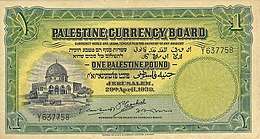 1939 One Palestine Pound | |
| Denominations | |
| Subunit | |
| 1/1000 | Mil |
| 1/1000 | Prutah (from 1949 in Israel) |
| Banknotes | 500 mils, 1, 5, 10, 50, 100 pounds |
| Coins | 1, 2, 5, 10, 20, 25, 50, 100 mils, 1, 5, 10, 25, 50, 100, 250, 500 prutot |
| Demographics | |
| User(s) | Transjordan (1927 – 25 May 1946) Jordan (25 May 1946 – 30 September 1950) Jordanian-occupied West Bank (1948 – 30 September 1950) Egyptian-occupied Gaza Strip (1948 – April 1951) Cyprus (1955) |
| Issuance | |
| Central bank | Palestine currency Board |
| Printer | Thomas De La Rue |
This infobox shows the latest status before this currency was rendered obsolete. | |

The Palestine pound was divided into 1000 mils or prutot (Arabic: مِل,; Hebrew: מִיל).
Today, the currencies in use in the Palestinian territories are the Israeli new shekel and the Jordanian dinar.[1]
History
Until 1918, Palestine was an integral part of the Ottoman Empire and therefore used its currency, the Ottoman lira. During 1917 and 1918, Palestine was occupied by the British army, who set up a military administration. The official currency was the Egyptian pound, which had been first introduced into Egypt in 1834, but several other currencies were legal tender at fixed exchange rates that were vigorously enforced.[2][3] After the establishment of a civil administration in 1921, the High Commissioner Herbert Samuel ordered that from 22 January 1921 only Egyptian currency and the British gold sovereign would be legal tender.[4]
In 1926, the British Secretary of State for the Colonies appointed a Palestine Currency Board to introduce a local currency.[5] It was based in London and chaired by Mr. P.G. Ezechiel, with a Currency Officer resident in Palestine.[5] The board decided that the new currency would be called the Palestine pound, fixed in value to the British pound and divided into 1000 mils.[6] The one pound gold coin would contain 123.27447 grains of standard gold.[6] The enabling legislation was the Palestine Currency Order, 1927, signed by the King in February 1927.[7] The Palestine pound became legal tender on 1 November 1927.[8] The Egyptian pound (at the fixed rate of 0.975 to the Palestine pound) and the British gold sovereign remained legal tender until 1 March 1928.[7][9]
The Palestine Currency Order explicitly excluded Transjordan from its application, but the Government of Transjordan decided to adopt the Palestine pound at the same time as Palestine did.[10][11] The Egyptian pound remained legal tender in Transjordan until 1930.[12]
All the denominations were trilingual in Arabic, English and Hebrew. The Hebrew inscription includes the initials Alef Yud after "Palestina", for "Eretz Yisrael" (Land of Israel).
It so happened that the new Palestinian currency was released, which was a great ordeal. The Palestinian currency which was coined especially for Palestine, and issued both in banknotes and coins, had the phrase “the land of Israel” written on it in Hebrew. Despite this hint, we accepted it, and the Arabs of Palestine dealt in it in what was almost an acknowledgment that Palestine was the land of Israel.
— Wasif Jawhariyyeh, The Storyteller of Jerusalem, page 698
The Currency Board was dissolved in May 1948, with the end of the British Mandate, but the Palestinian pound continued in circulation for transitional periods:
- Israel adopted the Israeli pound (or Israeli lira) in 1952. In August 1948, new banknotes were issued by the Anglo-Palestine Bank, owned by the Jewish Agency and based in London.
- Jordan adopted the Jordanian dinar in 1949.
- In the West Bank, the Palestine pound continued to circulate until 1950, when the West Bank was annexed by Jordan, and the Jordanian dinar became legal tender there. The Jordanian dinar is still legal tender in the West Bank along with the Israeli shekel.
- In the Gaza Strip, the Palestine pound continued to circulate until April 1951, when it was replaced by the Egyptian pound, three years after the Egyptian army took control of the territory.
The Oslo Accords (1993) provided that the Palestinian Authority will not issue its own currency and will use the Israeli or Jordanian currencies. Today, the Israeli new shekel and Jordanian dinar are the currencies in use in the Palestinian territories. The shekel is the main currency used in Gaza[13][14] and the primary currency for retail transactions in the West Bank. The dinar is used in the West Bank for savings and durable goods transactions.[1] The United States dollar is also sometimes used for savings and for purchasing foreign goods.[1] The Palestinian Authority can issue postage stamps and these are valued in terms of the Palestine pound, which Palestinian economists and officials regard to be a still-existent (though at present "dormant") currency, to be revived after Palestinian independence. In practice, prices in the Palestinian territories are quoted in Israeli currency.
The Palestinian Authority and Palestine Monetary Authority were considering issuing new banknotes and coins in 2010 and 2011[15] as part of a broader push by Prime Minister Salam Fayyad to make Palestine a viable independent state.[16] The PA and Palestinian Monetary Authority abandoned the idea of an independent Palestine pound in 2011.[17]
Coins
In 1927, coins were introduced in denominations of 1, 2, 5, 10, 20, 50 and 100 mils. The 1 and 2 mils were struck in bronze, whilst the 5, 10 and 20 mils were holed, cupro-nickel coins, except for during World War II, when they were also minted in bronze. The coin of 10 mils was also called a grush. The 50 and 100 mils coins were struck in .720 silver.
The last coins were issued for circulation in 1946, with all 1947 dated coins being melted down.
| Palestine pound Coinage | |||||||||
|---|---|---|---|---|---|---|---|---|---|
| Issued by the Palestine currency Board | |||||||||
| Image | Value | Technical parameters | Description | Date of first issue | Dated years of issue | ||||
| Diameter | Mass | Composition | Edge | Obverse | Reverse | ||||
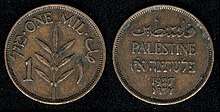 |
1 mil | 21 mm | 3.23 g | Bronze | Plain | "Palestine" in Arabic, English, and Hebrew, year of minting. In Hebrew; also mentions in the acronym (א״י) for Eretz Yisrael (Land of Israel). |
Value in Arabic, English, and Hebrew, olive sprig |
1927 | 1927, 1935, 1937, 1939, 1940, 1941, 1942, 1943, 1944, 1946 |
 |
2 mils | 28 mm | 7.77 g | 1927, 1941, 1942, 1945, 1946 | |||||
 |
5 mils | 20 mm | 2.91 g | Cupro-nickel | Value in Arabic, English, and Hebrew | 1927, 1934, 1935, 1939, 1941, 1946 | |||
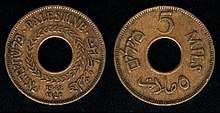 |
5 mills | 20 mm | 2.9 | Bronze | 1942 | 1942, 1944 | |||
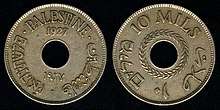 |
10 mils | 27 mm | 6.47 g | Cupro-nickel | 1927 | 1927, 1933, 1934, 1935, 1937, 1939, 1940, 1941, 1942, 1946 | |||
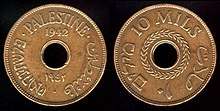 |
10 mils | 27 mm | 6.47 | Bronze | 1942 | 1942, 1943 | |||
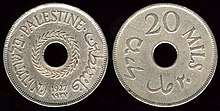 |
20 mils | 30.5 mm | 11.33 g | Cupro-nickel | 1927 | 1927, 1933, 1934, 1935, 1940, 1941 | |||
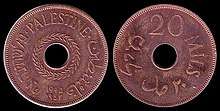 |
20 mils | 30.5 mm | 11.3 | Bronze | 1942 | 1942, 1944 | |||
 |
50 mils | 23.5 mm | 5.83 g | 720‰ Silver | Reeded | "Palestine" in Arabic, English, and Hebrew, year of minting, olive sprig. In Hebrew; also mentions in the acronym (א״י) for Eretz Yisrael (Land of Israel). |
1927 | 1927, 1931, 1933, 1934, 1935, 1939, 1940, 1942, 1943 | |
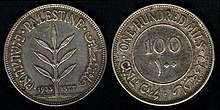 |
100 mils | 29 mm | 11.66 g | ||||||
| Issued by the State of Israel | |||||||||
| Image | Value | Technical parameters | Description | Date of first issue | Dated years of issue | ||||
| Diameter | Mass | Composition | Edge | Obverse | Reverse | ||||
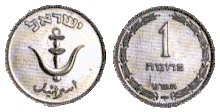 |
1 pruta[18] | 21 mm | 1.3 g | Aluminum | Plain | Anchor; "Israel" in Hebrew and Arabic.
The design is based on a coin of Alexander Jannaeus (76-103 BCE). |
The denomination "1 Pruta" and the date in Hebrew; two stylized olive branches around the rim. | 25 October 1950 | 5709 (1949) |
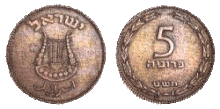 |
5 pruta | 20 mm | 3.2 g | Bronze | Four-stringed lyre; "Israel" in Hebrew and Arabic.
The design is based on a coin from the Bar-Kochba Revolt (132-135CE). |
The denomination "5 Pruta" and the date in Hebrew; two stylized olive branches around the rim. | 28 December 1950 | ||
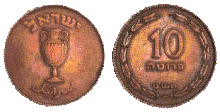 |
10 pruta | 27 mm | 6.1g | Two-handled amphora; "Israel" in Hebrew and Arabic.
The design is based on a coin from the Bar-Kochba Revolt (132-135CE). |
The denomination "10 Pruta" and the date in Hebrew; two stylized olive branches around the rim. | 4 January 1950 | |||
 |
25 mil | 30 mm | 3.8 g | Aluminum | Cluster of grapes, based on coins struck during the Bar-Kochba Revolt (132-135 CE); "Israel" in Hebrew above and in Arabic below. | The denomination "25 Mil" in Hebrew and Arabic; date in Hebrew below; two stylized olive branches around, based on coins struck during the Bar-Kochba Revolt (132-135 CE). | 6 April 1949 | 5708 (1948),
5709 (1949) | |
 |
25 pruta | 19.5 mm | 2.8 g | Cupro-nickel | Reeded | Value and date in Hebrew within wreath. | 4 January 1950 | 5709 (1949) | |
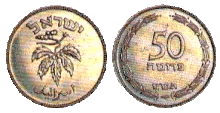 |
50 pruta | 23.5 mm | 5.69 g | A Branch of Grape Leaves. | Value and date within wreath made up of two stylized olive branches that for a circle around perimeter. | 11 May 1949 | |||
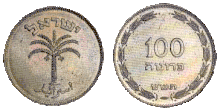 |
100 pruta | 2.4 mm | 28.5 mm | Date palm tree with seven branches and two bunches of dates. Country name is listed in Hebrew and Arabic. | Value and date in Hebrew within wreath of stylized olive branches. | 25 May 1949 | |||
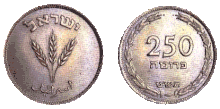 |
250 pruta | 32.2 mm | 14.1 g | Three palm branches; "Israel" in Hebrew and Arabic.
The design is based on a coin minted during the Great Revolt (66 - 70 CE). |
The denomination "250 Pruta" and the date in Hebrew; two stylized olive branches around the rim. | 11 October 1950 | |||
| These images are to scale at 2.5 pixels per millimetre. For table standards, see the coin specification table. | |||||||||
Banknotes
On 1 November 1927, banknotes were introduced by the Palestine Currency Board in denominations of 500 mils, 1, 5, 10, 50 and 100 pounds. Notes were issued with dates as late as 15 August 1945.[19]
| Palestine pound Banknotes | |||||||||
|---|---|---|---|---|---|---|---|---|---|
| Issued by the Palestine currency Board | |||||||||
| Image | Value | Dimensions | Main Colour | Description | Date of first issue | Quantity circulated at the end of the Mandate | |||
| Obverse | Reverse | Obverse | Reverse | Watermark | |||||
 |
500 mils | 127 × 76 mm | Purple | Rachel's Tomb | Citadel and Tower of David | Olive sprig | 1 September 1927 | 1,872,811 | |
 |
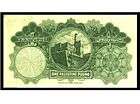 |
1 pound | 166 × 89 mm | Yellowish green | Dome of the Rock | 9,413,578 | |||
 |
5 pounds | 192 × 103 mm | Red | Tower of Ramla | 3,909,230 | ||||
 |
10 pounds | Blue | 2,004,128 | ||||||
 |
50 pounds | Purple | 20,577 | ||||||
 |
100 pounds | Green | 1,587 | ||||||
| "Palestine" in Arabic, English, and Hebrew. In Hebrew; also mentions in the acronym (א״י) for Eretz Yisrael (Land of Israel). | |||||||||
| Issued by the Anglo-Palestine Bank (State of Israel) | |||||||||
| Image | Value | Dimensions | Main Colour | Description | Date of | ||||
| Obverse | Reverse | Obverse | Reverse | Issue | Ceased to be legal tender | ||||
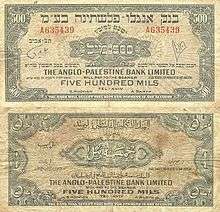 |
500 mils[18] | 148 x 72 mm | Grey-pink | Guilloches; the denomination and "The Anglo-Palestine Bank Limited" in Hebrew and English. | Guilloches; the denomination and "The Anglo-Palestine Bank Limited" in Arabic and English. | 18 August 1948 | 23 June 1952 | ||
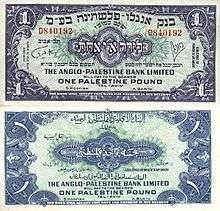 |
1 pound | 100 x 75 mm | Blue-green | ||||||
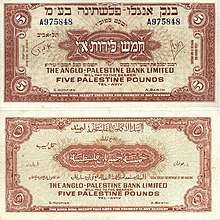 |
5 pounds | 105 x 68 mm | Brown | ||||||
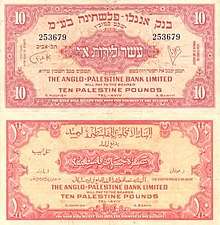 |
10 pounds | 150 x 80 mm | Red | ||||||
 |
50 pounds | 159 x 84 mm | Violet | ||||||
The 100 pound note was equivalent to 40 months’ wages of a skilled worker in Palestine.[20] Currently six of them are unaccounted for and four are known to exist in the hand of collectors. Their serial numbers and dates are:
- A000719 - 1 September 1927
- A000935 - 1 September 1927
- A001020 – 30 September 1929
- A001088 – 30 September 1929
See also
- The History of British Currency in the Middle East
- Economy of Israel
- Economy of the Palestinian territories
- Economy of Jordan
References
- Cobham, David (2004-09-15). "Alternative currency arrangements for a new Palestinian state". In David Cobham, Nu'man Kanafani (eds.). The Economics of Palestine: Economic Policy and Institutional Reform for a Viable Palestine State (PDF). London: Routledge. ISBN 9780415327619. Retrieved 2018-08-22.CS1 maint: uses editors parameter (link)
- Egyptian Expeditionary Force, The Palestine News, March 7, 1918, p2. Turkish coins but not Turkish notes were legal. In January, a resident of Jerusalem was sentenced to 3 months' hard labour for selling a French Napoleon for 92.5 piastres instead of the regulation 77.15 piastres.
- Egyptian Expeditionary Force, A Guide-Book to Central Palestine, August 1918, p106.
- Official Gazette of the Government of Palestine, No. 36, 1 February 1921, p13.
- Official Gazette of the Government of Palestine, No. 170, 1 September 1926, pp447–449.
- Official Gazette of the Government of Palestine, No. 182, 1 March 1927, pp131–134.
- Official Gazette of the Government of Palestine, No. 193, 16 August 1927, pp590–592.
- Official Gazette of the Government of Palestine, No. 196, 1 October 1927, p679.
- Official Gazette of the Government of Palestine, No. 205, 16 February 1928, p94, and No. 206, 1 March 1928, p114.
- Howard M. Berlin (2015). The Coins and Banknotes of Palestine Under the British Mandate, 1927-1947. McFarland. p. 22.
- Palestine Currency Board, Report for the period ending 1st March 1928.
- Howard M. Berlin (2015). World Monetay Units: An Historical Dictionary, Country by Country. McFarland. p. 85.
- "Palestinian Territories > Gaza Strip > Currency". Lonely Planet. Retrieved 22 August 2018.
- "استبدال العملات التالفة وإدخال الفكة و15 مليون دولار لغزة". سوا: وكالة انباء فلسطينية مستقدمة. June 25, 2018. Retrieved August 22, 2018.
- "Palestine considers issuing its own currency". Banknote News. September 22, 2010. Retrieved 22 August 2018.
- Zacharia, Janine (2010-05-31). "Palestinian officials think about replacing Israeli shekel with Palestine pound". Washington Post. ISSN 0190-8286. Retrieved 2018-08-22.
- Lauria, Joe (2014-08-09). "Getting Money in Gaza: An Interview With Palestine's Central Banker". Huffington Post. Retrieved 2018-08-22.
- "Bank of Israel - Past Notes & Coins Series - Past Notes & Coin Series". www.boi.org.il. Retrieved 2017-11-30.
- Linzmayer, Owen (2012). "Palestine". The Banknote Book. San Francisco, CA: www.BanknoteNews.com.
- Berlin, Howard M (2001). The coins and banknotes of Palestine under the British mandate, 1927-1947. Jefferson: McFarland. p. 71. ISBN 978-0786408795.
- Krause, Chester L.; Clifford Mishler (1991). Standard Catalog of World Coins: 1801–1991 (18th ed.). Krause Publications. ISBN 0873411501.
- Pick, Albert (1994). Standard Catalog of World Paper Money: General Issues. Colin R. Bruce II and Neil Shafer (editors) (7th ed.). Krause Publications. ISBN 0-87341-207-9.
- Berlin, Howard (2005). The Coins And Banknotes of Palestine Under the British Mandate, 1927-1947. McFarland & Company. ISBN 0-7864-2445-1.
- Memorandum relating to currency arrangements. In: Official Gazette of the Government of Palestine, 9. 1927, no. 182 (1.03.1927), pp. 131–134.
- Currency Notes Ordinance 1927. In: Official Gazette of the Government of Palestine, 9. 1927, no. 184 (1.04.1927), pp. 249–252.
- Palestine Currency Order 1927. In: Official Gazette of the Government of Palestine, 9. 1927, no. 193 (16.08.1927), pp. 590–592.
- Notice: Palestine Currency. In: Official Gazette of the Government of Palestine, 9. 1927, no. 197 (16.10.1927), pp. 726–727.
